Your Handy 1970–81 Pontiac Firebird Buyer’s Guide
In 2000, High Performance Pontiac magazine featured a wide-ranging interview with Bill Porter, chief designer at the GM Design Center, and studio chief at Pontiac Styling through 1979, the meat of development years for the second-generation Pontiac Firebird. By the time he’d worked his way up to studio chief, he said, the first-generation Firebird was just about wrapped up. “I never identified with that car personally,” he said. “But that ’70½ second-generation Firebird was another story altogether. I was absolutely crazy about that car from day one and I really threw myself into it. I put the best designers on it, and we were consciously trying to create an important American sports car. We knew we had our chance, and we wanted to do it bad.”
They did, and it was bad, in the best sense of the term. With the exception of the Corvette, the Trans Am and the Formula 400 were the baddest street cars available at that time, cramming high-horsepower 400-cubic-inch V-8s into a platform built to turn as well as it took off in a straight line. The Camaro was tough enough, but the Pontiac Firebird—with its own interior and exterior design staff and engineering teams—kept Pontiac on the map during some exceedingly grim years in the 1970s.
Of course, the Trans Am and Formula 400 get the attention, but lower-trim cars like the Esprit were massively popular. Long before Burt Reynolds drove a Trans Am in 1977, Jim Rockford put a series of brown Esprits in millions of American living rooms. Sales commensurately took off and stayed elevated throughout the entire decade, almost until the very end of production.
From the beginning, the Firebird was a driver’s car, and not just for drivers of the hot-performing trim levels. It went right down to the base car, and everybody involved with the Firebird’s production wanted to deliver a holistic driving experience.
Good ergonomics, for example, were a Firebird standard feature in every trim level. “Too many people cling to the notion that the inside of a sports car—especially a low-budget sports car—is a wind-in-the-face, knees-in-the-chest, pain-in-the-neck,” read the promotional material. Even the back seat gets a mention for its overall comfort, comparing its relative spaciousness to international sports cars that considered the rear seat an afterthought better suited for bag lunches than human occupation.
The basic shapes of the interior were similar to the Camaro, but as Porter mentioned in his interview, there was a unique synergy between the inside and the outside of a second-gen Firebird that might have been a bit lacking in the Chevrolet. “One of the design approaches pioneered in the ’70½ F-car and that’s coming into the industry in a more widespread way is the integration of the interior and exterior,” he said.

John Shettler designed the interior of the Firebird to mimic shapes that were used on the outside of the car. “I actually had templates taken off the grille openings and the nose profile,” said Porter. “John used those for the seatback shapes, the instrument panel cowl shapes . . . so that the exact same curves were used through the interior and exterior of the car. When you open the door of a Firebird, there is—I would like to think—a subliminal sense of the unity of the interior and exterior.”
John DeLorean—at the time general manager of the Pontiac Division—exerted his own influence on the interior design. “[I]f your hand didn’t fall right where it should’ve been when you reached for the shifter, or maybe for a switch, [DeLorean] and Johnny [Shettler] would talk about it, make modifications and try again,” said Porter. “Everyone involved with that vehicle wanted it to be really good, not only from a performance standpoint, but from an ergonomic standpoint.”
Like all cars of the era, the Firebird was challenged by increasing restrictions from the EPA and corporate mandates, by inflation, and by the general malaise that overtook the country, but it simply didn’t seem to hurt what most Americans considered to be a fun, good-looking mode of daily transportation. Especially in the early years of production, it wasn’t the Trans Am or the Formula 400 that kept customers flowing into Pontiac showrooms. From 1970 to 1976, it was the Esprit and the base trim Firebird that represented the largest sales volumes. That’s kind of fascinating for a car that has long been synonymous with the excess of the era.
1970

Depending upon who you talk to, the second-gen Firebird was a 1970 or a 1970½. Porter talks about the half-year, but the brochure clearly identifies it as a 1970. Regardless, the Camaro and Firebird debuted within a day of each other, on February 25 and February 26, 1970.
Like the Camaro, these cars were built at the Norwood, Ohio, and Van Nuys, California, plants. Later in the production run—from ’72 to ’77—Norwood exclusively built Firebirds. Cars built in Norwood will have an “N” in the fourth digit of the VIN from 1970 to 1971, in the sixth digit of the VIN from 1972 to 1980, and in the ninth digit in 1981, when the 17-digit VIN finally arrived. Van Nuys cars will all have an “L” (for Los Angeles) in the same positions.
Pontiac offered four trim levels in 1970: The “basic Firebird,” as identified in the sales brochure, the Esprit, the Formula 400, and the Trans Am.
“Economy is what the basic Firebird is all about,” read the copy, leaning on the car’s overall value proposition rather than its performance. The Endura nose, for example, is called out for its long-lasting resistance to dents and chips and its imperviousness to rust. The long door with no rear quarter window is identified for ease of access to the rear seat.
The base car sadly avoided the Pontiac-specific overhead-cam straight-six in favor of Chevrolet’s 250-cubic-inch six, though a Pontiac-specific 350-cid V-8 was available. Horsepower jumped from 155 in the six to 255 in the V-8, with the larger engine putting out an impressive 355 lb-ft of torque. It made a base 1970 Firebird with a 350 and a Hurst-shifted four-speed a smoking bargain.
The Esprit was marketed as a “luxury” Firebird, but not at the expense of performance. “We never let luxury get in the way of sport,” read the promotional materials. “You won’t find anything frivolous or wasteful about Esprit’s kind of luxury.” And you won’t, especially through a modern lens. “Luxury” includes things like knit vinyl upholstery (along with straight vinyl and cloth options), an available console, storage pockets in the doors, and “soft, squeezable vinyl” wrapping the wheel. Even in the “luxurious” Esprit, power steering was still an option, but you did get chrome window opening trim, and a 15/16-inch front stabilizer bar.
A differentiator from the Camaro was the fact that the Esprit was only available with a V-8 engine, either the base 350 or a 265-horse 400-cid V-8 with almost 400 lb-ft of torque. You could buy an Esprit with a manual transmission, but only the three-speed, and only with the 350. The Esprit with a 400 came exclusively with a TH350 automatic.
In nearly every way, the Formula 400 may have been the best car in the Firebird lineup for 1970. With its lack of spoilers, side scoops, and tape stripes, the Formula is a much cleaner design, hewing close to the car’s original sketches and avoiding nearly all identifying markers except for the fender callouts. The brochure called the styling “almost stark.” Dual exhaust, a flexible fan, fat front and rear stabilizer bars, and F70-14 tires were all part of the trim level.
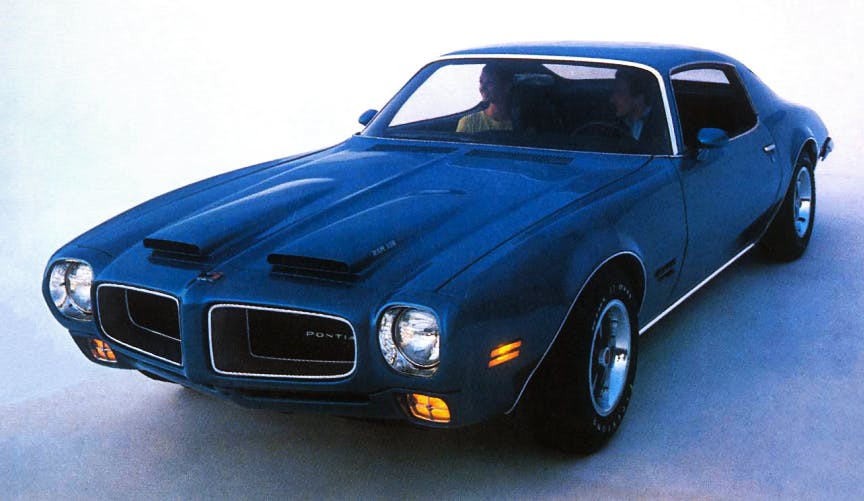
The Firebird 400 featured—as the name implies—the 400-cid V-8, delivering 330 hp and 430 lb-ft of torque. The 400 could also be had with the 345-horse Ram Air III package (the same engine was rated at 366 hp in the GTO), though fewer than 700 were so-equipped. The Hurst-shifted three-speed was the base transmission, with a four-speed or an automatic transmission on the options list. The optional Ram Air twin-snorkel hood scoop was a particular bone of contention for Bill Porter. “I always kind of wished the double-scooped hood that became the Formula hood—originally done for the Trans Am—would have prevailed [as the hood for the Trans Am] because it’s functionally superior,” he said. “Those twin boundary scoops up front really gulp in the air.”

Top shelf was the Trans Am, with its spoilers, air extractors, and shaker scoop, all of which was functional. The 345-horse Ram Air III came standard in the T/A, while the 370-horse Ram Air IV 400 was an option that only 88 buyers took advantage of. The stabilizer bars are the thickest available for 1970, with 1¼-inch up front and 7/8-inch in the rear. Heavy-duty shocks, Rally II wheels without trim rings, and F70-15s rounded out the handling package.
There were 15 color options in 1970, and that year, Pontiac produced 18,874 base Firebirds, 18,961 Esprits, 7708 Formulas, and just 3196 Trans Ams. Watch that Trans Am number between now and 1979, because it goes through some wild fluctuations.
1971

The biggest news for 1971 was in the engine room of the Formula and Trans Am trims. The Formula now offered the two-barrel 350 and a four-barrel 400, and the cars were identified as “Formula 350” and “Formula 400.” Then there was the Formula 455, which shared the 455-cubic inch V-8 with the Trans Am. Compression ratios had dropped across the board, but the 455 was available in two flavors: The four-barrel 455 delivered 255 net horsepower (though gross horsepower was still listed in the brochure), with 455 lb-ft of torque. Then there was the 455 HO, with 305 net horsepower and a Wide Oval–boiling 480 lb-ft of torque.
Several trim items were revised, too, including fake side air extractors all the way down to the base Firebird, a new console-like armrest with an ashtray between the rear seats, and new Polycast honeycomb wheels. Bill Porter designed those himself, with the help of Maurice “Bud” Chandler, with whom Porter shares a patent. “It was inspired by Buckminster Fuller’s geodesic domes that I had admired since I was a student,” said Porter. “The idea of doing a wheel with a deep cell structure that would be inherently strong, not only radially but laterally, was intriguing.” Porter’s intent was to make the wheels completely aluminum, but that never made it to production. Instead, they were Polycast, “much to my regret,” said Porter. “In the Polycast approach, all of the structural requirements are taken care of by the underlying stamped steel wheel. The honeycomb pattern—now an injection molded appliqué—merely goes along for the ride, reduced to just so much pastry icing, only there for its decorative pattern.”

For 1971, again, 15 colors were available. Pontiac produced 23,021 Firebirds, 20,185 Esprits, 7802 Formulas in all three engine sizes, and 2116 Trans Ams.
1972

The Firebird underwent some exterior changes in 1972, including a new honeycomb grille pattern that mirrored the design of the Polycast wheels. Inside, the front seats all featured a new high-back design, the third consecutive year the front bucket seat design changed. In 1970, the low-back seats had small individual headrests. In 1971, the seat backs got slightly taller and the headrests left. And for 1972, the headrest was fully integrated into the high-back design, which would essentially carry through until the end of second-generation Firebird production.
Power outputs took it on the chin across the board, with the 250-cubic-inch six dropping to 110 hp, the 350 two-barrel to 160 hp, the 400 two-barrel to 175, and the 400 four-barrel to 250 hp. The standard 455 in the Formula 455 and Trans Am was eliminated for 1972, focusing solely on the HO, which dropped to 300 hp and 415 lb-ft of torque. (Some of the change in output coincided with the switch from SAE gross to SAE net calculations.)
The VIN code change for 1972 is significant. Prior to 1972, the only engine identification in the VIN was that V-8 cars had serial numbers starting at 100001, and six-pluggers started at 600001. From 1972 through 1980, the VINs got much more specific, helping future owners understand the DNA profile of their Firebirds. These letter designations change through the years, though they are fairly consistent for the next three model years. For a more explicit breakdown, visit PontiacFormula.Free.fr:
- D = 250-cid
- M = 350-cid 2-barrel, single exhaust
- N = 350-cid 4-barrel, dual exhaust
- P = 400-cid 2-barrel, dual exhaust
- R = 400-cid 4-barrel, single exhaust
- T = 400-cid 4-barrel, dual exhaust
- X = 455-cid HO 4-barrel, dual exhaust
Fifteen colors were again available in 1972. Thanks to a UAW strike, this is the lowest-production year for the second-generation Firebird, with just 12,000 base cars, 11,415 Esprits, 5250 Formulas, and a scant 1286 Trans Ams.
1973

It’s interesting to consider just how far ahead Pontiac was with the Firebird compared to the Camaro. Over at Chevrolet, there was hustling afoot to make the split bumper comply with new 2.5-mph crash requirements. The second-generation Firebird was born with it, thanks to the Endura bumper, which required no design changes to comply, regardless of trim level. The slender rear bumpers were beefed up a bit, but still chrome.
Inside, the Esprit got a “Custom Interior” as standard, with deeply scooped bucket seats, a grab handle on the dash for the passenger, rear ashtrays, a fitted rubber trunk mat, and a body-color insert on the exterior door handles. The Custom Interior package was optional on the Formula and Trans Am.
And most notably, the exterior of the Trans Am featured—for the first time—the bird decal on the hood that had been an emblem and a small decal in prior years. Porter said he sketched it roughly on a napkin and had intended it for the 1970 Trans Am. Norm Inouye—who later attained greater fame for designing the logo for Disney’s EPCOT Center—worked out the graphics, and Porter had it applied on two concept cars. “[GM styling chief Bill] Mitchell saw it in the paint shop and just went into one of his horrible tantrums. I was back in the studio. He called me up and I had to hold the phone away from my ear. That was the end of that,” said Porter.
But three years later, designer John Schinella had another bite at the apple. Schinella had worked on the Chaparral 2, the Mako Shark II, the ’67 Camaro, and the ’68 Corvette, before making his way to Pontiac. In a 2014 interview I conducted with Schinella for Bangshift.com, Schinella shared that Mitchell was driving a Trans Am in custom John Player Special livery that had been a show car. Schinella had a set of gold foil decals made up, applied them to the John Player Special car Mitchell was driving, and parked it outside Mitchell’s office. Evidently, that was enough to seal the deal for the hood bird to reach production.
Power reset again for 1973, with a paltry 100 hp for the inline-six, 150 for the 350 two-barrel, 170 for the 400 two-barrel, and 230 for the 400 four-barrel. The 455 HO disappeared, and in its place were the 455 four-barrel with 250 hp, and—one of the last significant muscle car–era engines—the 455 Super Duty with 310 hp.
A choice of 16 colors provided the most extensive palette to date, and seven vinyl top colors expanded the range as well. Five interior colors were available, but only two were available in cloth trim. Production picked back up to more normal levels, with 14,096 Firebirds, 17,249 Esprits, 10,166 Formulas, and 4802 Trans Ams.
1974

The 5-mph federal bumper standards came into effect for the 1974 model year, and it changed the nose of the second-generation Firebird for the first time. As a result, the Endura bumper morphed into something that was much more in line with the design of the Camaro.
The bumper itself is interesting and unique to the Firebird. Instead of the aluminum bumper that the Camaro had, the Firebird got a full rubber bumper, along with bumperettes that were all cast in one giant rubber piece. A body-color Endura chin piece covered most of it and provided the housings for the lower air intakes and marker lights.
Inside, seat belts changed to a three-point design, which moved through a seat-mounted holder, along with an inertia reel.
Power steering moved to the standard features list for all Firebirds, while power brakes became standard on the Trans Am. The fuel tank increased from 18 gallons to 21. Mechanical changes also included the late introduction of HEI ignition on the 400 and 455 engines, beginning around May 1, 1974. The balance of the engines kept their points distributors.
Sixteen colors made up the paint options. Production ramped in a big way, with 26,372 Firebirds, 22,583 Esprits, 14,519 Formulas, and Trans Ams broke the five-digit mark for the first time, with 10,255 units.
1975
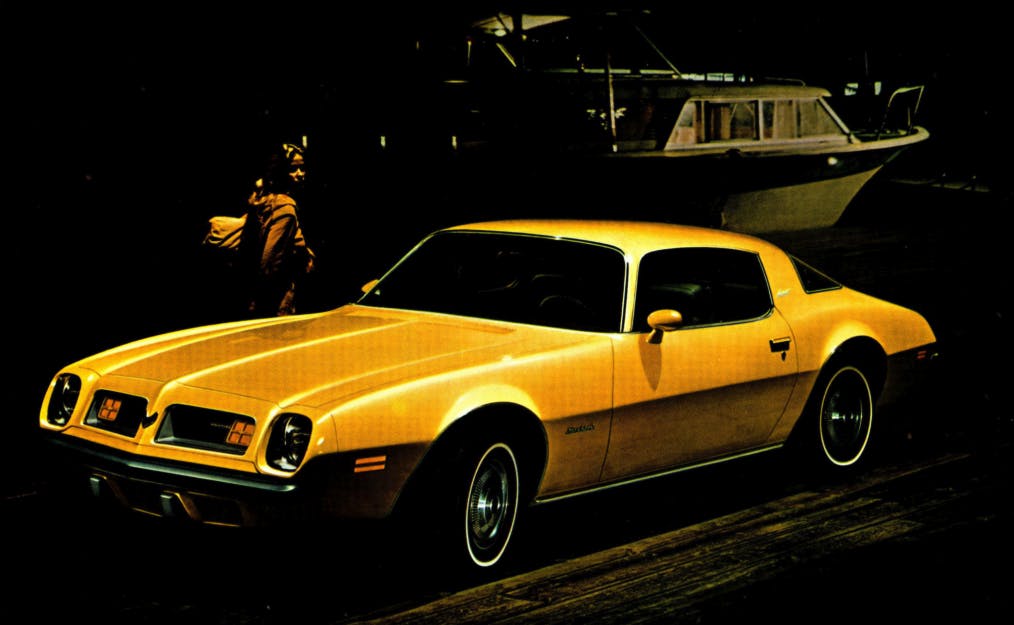
The HEI distributor made its way to all Firebirds for the 1975 model year, and that’s probably the only positive news for performance. It was part of what the brochure pitched as “The Pontiac Travel Plan,” which included radial tires and a catalytic converter. The 455 bowed out, and the Trans Am instead featured a 400 four-barrel just like the Formula.
There were only minor exterior updates again, including the ever-moving marker lamps, which now moved up to the grille inserts. Like the Camaro, this was the year the Firebird got a wraparound rear window for better visibility, made more crucial because of the high-back bucket seats.
The brochure shows a new AM/FM stereo as an option, along with infant and child love seats (GM-branded baby seats), which were a first-time option for the Firebird. Again, 16 colors were available, but black was not one of them. Production dipped slightly to 22,293 Firebirds, 20,826 Esprits, 13,670 Formulas, and—in what would now be a relentless march skyward for the next four years—27,274 Trans Ams.
1976

Most of the changes for 1976 were cosmetic, but they seem rather dramatic in some cases. Take the Formula, for example: The twin scoop hood was still there, but it was drastically scaled back for 1976, with the two nostrils almost vestigial and moved back at least 10 inches on the hood.
Two full model years before the Camaro had them, the Firebird sported monochrome bumper covers rather than the aluminum bumper employed over at Chevrolet. It made the Firebird look much more modern, and it provided some interesting color contrast between the standard Firebird and the Formula, which now had more elaborate lower colors and graphics. The “Canopy” vinyl roof was new for 1976, essentially a reverse landau top with the vinyl over the front passenger compartment.
Hurst T-Tops were available for the first time in 1976, a late-enough option that they didn’t make the brochure that year. They were only available on the 1976 Trans Am Special Edition and had unique, one-year-only weatherstripping that both sealed the T-Tops and held up the headliner. The design changed in 1977 to a plastic trim held in with a series of screws. The Hurst T-Tops used between 1976 and 1978 were smaller—only 30¼ inches x 17½ inches wide—and left a foot of roof between the two panels.
In the engine room, things carried on pretty much as before, with a 250-cubic-inch inline-six as the standard in the Firebird, with a jump up to a 350 as an option. Formulas had a TH350 automatic as standard equipment, which was optional on all other trims.
There were 14 colors for 1976. This was the first year when Trans Am production really started to raise some eyebrows. The Firebird still sold respectably at 21,209 units, with another 22,252 for the Esprit. The Formula still sold well at 20,613, but the Trans Am massively outpaced all other Firebird trims at 46,701 cars.
1977

You can make arguments for the merits of Firebird design prior to 1977, but this is the Trans Am that everyone remembers, thanks to the second-most popular movie that year behind Star Wars. For the first time, the Trans Am was the halo car, showcased prominently on the cover and the opening spread of the Pontiac brochure.
The biggest obvious change was the nose, with a phoenix-like beak, and four DOT-certified rectangular headlamps, set deep into the grille. The front fascia is one continuous piece, and it set the stage for more elaborate soft bumper covers to come. Incredibly, this icon of Pontiac design was around for just two years before it underwent a significant change in 1979.
The initial 1977 Trans Ams had shaker scoops that were recessed a bit into the hood, before a design change made the scoop more prominent later in the production year. Formulas also got another revision to their twin-nostril scoops, which moved them from the center of the hood to the leading edge, for a more aggressive look. Formulas and Trans Ams both shared the iconic chrome quad exhaust outlets.
Wheel and wheel cover designs changed as well, with Trans Ams using the Rally II as the base offering, while new cast aluminum wheels to replace the old honeycombs were available on all trim levels. Firebird, Esprit, and Formula all had a spoked wheel cover available as an option, a tragedy for any Formula.
Sadly, the lesser Firebirds really started to get pushed to the back of the line, though they did have their own redesign for 1977. With it came the all-new 3.8-liter Buick V-6, years before the Camaro would finally move away from the mid-1960s–era 250 as the base engine. The Buick 3.8-liter was as good here as it was in the rest of GM’s lineup, providing 105 hp and 185 lb-ft of torque. For the first time, the Esprit would start out with a six-cylinder as the base engine.
The Formula also got serious engine revisions, including an all-new Pontiac 301-cubic-inch two-barrel V-8 as the base engine, which providied 130 hp. That engine was optional on both the Firebird and the Esprit, along with an Oldsmobile 350 with a four-barrel that was available on all three lower trims. A Chevy 305 would come in later as well. The larger engine options in the Formula and Trans Am got even more busy. The 180-horse L78 400 Pontiac engine was available only with an automatic and was visually identified by the “6.6 Litre” on the Trans Am’s shaker scoop. The hotter 200-horse W72, denoted by the “T/A 6.6” on the scoop, was available with a manual or automatic. California and high-altitude locations got a 403-cubic-inch Oldsmobile V-8 rated at 185 hp.
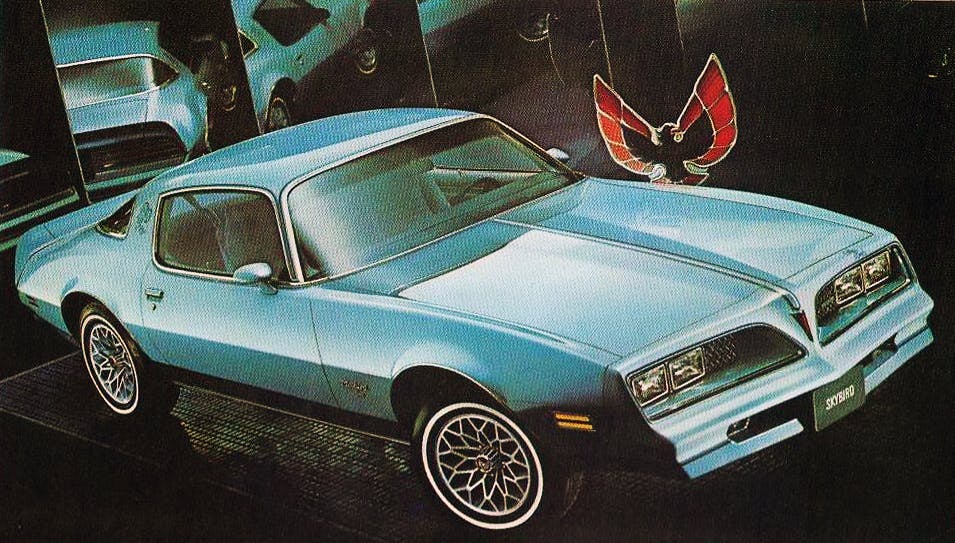
New for 1977 was the Sky Bird, which was an appearance package only available on the Esprit. It featured blue velour seats, two-tone blue paint, cast aluminum wheels with unique blue-painted inserts, a dark blue rear panel, blue grille panels, and accent stripes.
Colors became more limited in 1977, with just 13 offered. All sales ticked up in 1977: The Firebird sold 30,642 cars, the Esprit 34,548, and the Formula 21,801, while Trans Am sales grew to 68,745.
1978
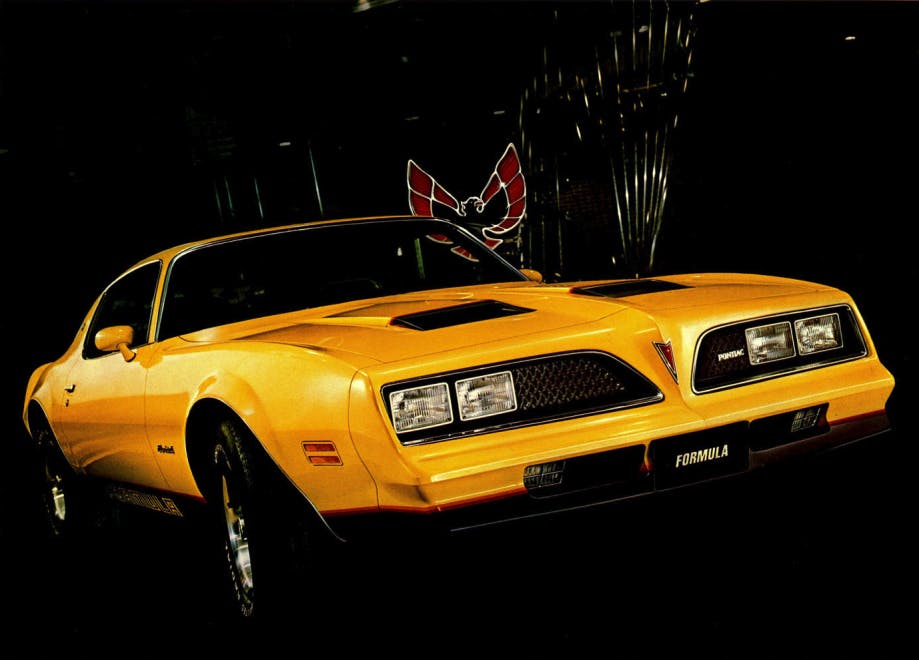
Styling didn’t change much at all, with a gold Trans Am stealing the show on the cover and the first spread in the brochure. There were slight revisions, with the grille surrounds in black, but otherwise, the design went essentially unchanged.
The T-Tops were still the Hurst design, featuring screwed-in plastic pieces that held up the headliner. Continuing through the interior, cruise control appeared on the options list. The radios included a new AM/FM stereo with a digital readout, though it was still an analog tuner.
Power increased on the W72 6.6-liter V-8 to 220 horses, making it the engine to have. Some sources note that it was partway through the ’78 model year that the automatic ceased to be available with the W72.
While the Camaro offered just nine colors, the Firebird palette grew to 14. Sales for 1978 saw growth across the board, with the Firebird at 32,672, Esprit at 36,926, Formula at 24,346, and the Trans Am at a staggering 93,341 units.
1979

Depending on who you ask, 1979 might be the last year for the “real” second-generation Trans Am. It marked the end of 400-cubic inch V-8 production.
The basic shape was unchanged, but it was bookended by radically different front and rear fascias. The front was a return to something similar to the Endura nose, a rubberized nose cover unbroken by anything but low-mounted grille openings with the marker lights at the outside edges, and four headlamp buckets. The nose design was shared throughout the Firebird lineup, with the exception of the Trans Am’s chin spoiler.
At the rear, the pads on the bumpers mirrored the design of the grille up front. Replacing the individual taillamps was a full-width red panel that hid the fuel filler and incorporated the lights, predating designs that used full-width LED lamps by 40 years.
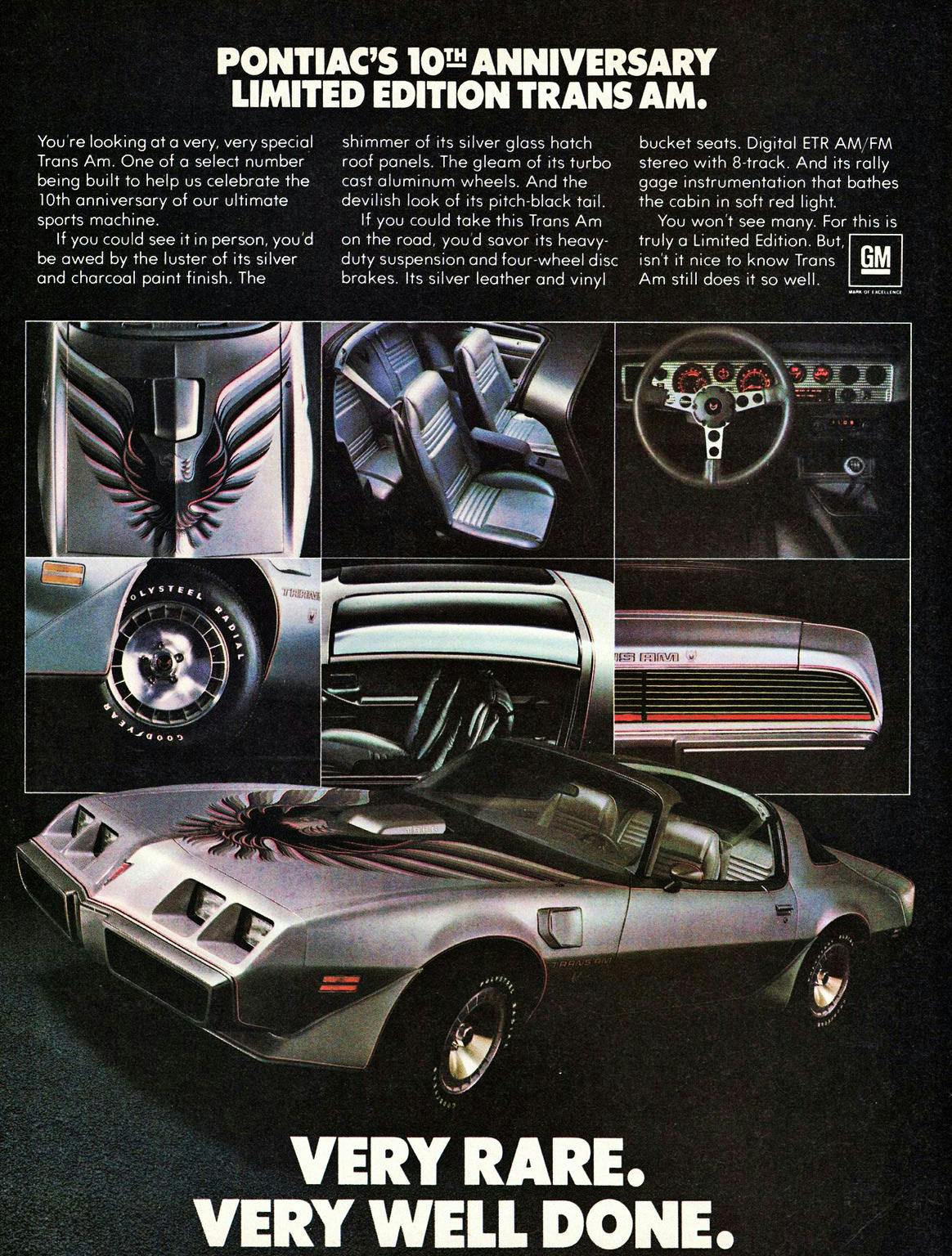
The 10th Anniversary Trans Am was a bona fide hit, with a ton of unique features that had never been available before, including mirrored T-Tops, leather seats, and a hood bird that reached the front fenders for the first time. These cars had their own unique X87 VIN code and only one option: The Olds 403 with an automatic, or the Pontiac 400 with the four-speed. Base price was a hefty $10,620, or nearly $46,000 in 2024 dollars.
If there’s one thing to take note of for 1979, it’s that it was all Trans Am. The Formula Firebird rated exactly one picture in the Pontiac brochure. The Esprit and Firebird none at all, though the Esprit did have a special package in the Red Bird, which replaced the Sky Bird. It was essentially the same idea but red instead of blue.
Mechanical changes were few but presaged what was coming in 1980: For the first time, the Trans Am was available with a small-block V-8, the 301 that was optional in the standard Firebird. High-altitude cars were available for the last time with a Chevrolet 350, and California was only offered the optional 305.
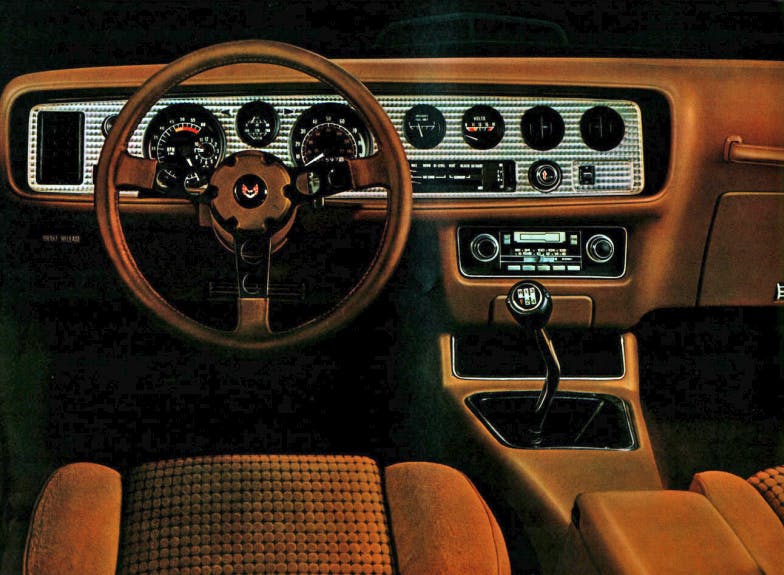
There was also the addition of four-wheel disc brakes as part of the WS6 package, which included fat stabilizer bars and wide 8-inch wheels. The big issue was the take rate on the package, which caused supply chain issues and resulted in Pontiac offering a WS7 package that included everything but the brakes.
The T/A was so immensely popular in 1979 that the last page of the brochure featured a pitch for a limited-edition 20 x 50-inch poster of the car, which was available for $2. Again, 14 colors were offered, and 1979 marked the most popular year ever for the nameplate: Pontiac sold 38,642 Firebirds and 30,852 Esprits (the first year that trim level had seen a dip since 1975). The Formula managed to hold steady at 24,851 cars. For Trans Am sales, though, hold onto your hats: 117,108 cars were produced, a number it would never come close to again.
1980
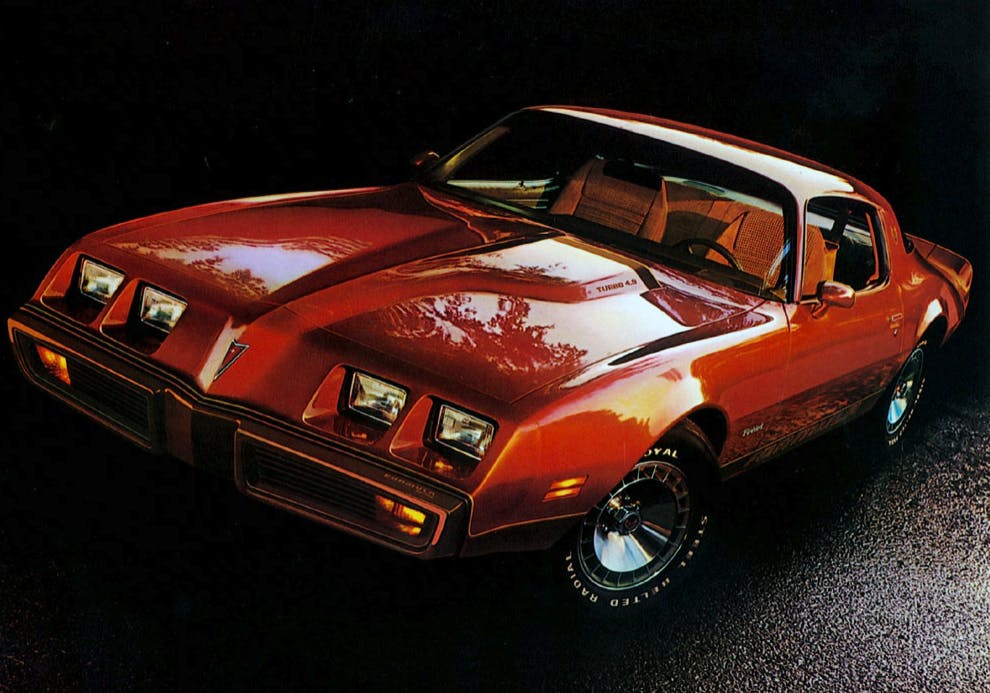
The Turbo Trans Am got a bad rap in its day, but it’s actually a more exciting car than most people thought in 1980. That year’s 301 wasn’t the run-of-the-mill engine that it had been in years prior. The block was beefier, along with the head gasket and pistons, and there was a high-pressure oil pump. The turbocharger was electronically controlled and was shipped over to Pontiac from Buick, which knew a thing or two about turbocharging. The Garrett TBO-305 delivered 9 psi of boost and used a modified Q-Jet four-barrel and a knock sensor, just like the early T-Type from Buick. (Imagine what might have happened if the second-gen had hung around long enough to steal the Grand National’s later setup . . .)
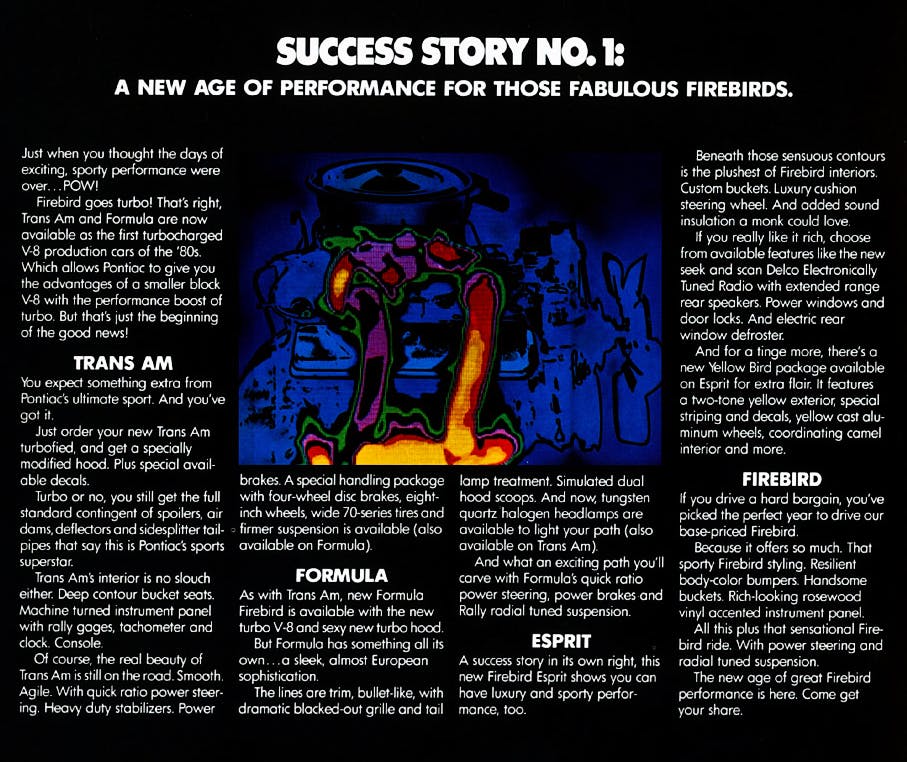
The engine delivered 210 hp, which wasn’t much to get excited about, but torque was respectable at 345 lb-ft. Sadly, this engine was crying out for a manual but only got an automatic, with a 3.08 rear gear to boot. That put the kibosh on any enthusiasm for the car, as did the 17.02-second quarter-mile that Car and Driver reported that year.

The other major intro for 1980 was the Indy Pace Car, 5700 of which were built in Cameo White with gray details. The Esprit had one more trick up its sleeve with the Yellow Bird appearance package, which continued the legacy of the Sky Bird and Red Bird before it.
This was also the first full year of the Fisher T-Top, which replaced the Hurst T-Tops that required cars be shipped out to Hurst for modification. Now they were built right at Fisher Body, and the modified design addressed a few issues. First, instead of having two latches at front and rear, the Fisher T-Tops had just one latch, with pins at the front and rear that extended into matching holes in the roof. They were also 3 inches longer, stretching back to match the side window opening. And they were each 5 inches wider, leaving a narrow strip of just 4 inches of steel roof between the two panels. If there’s anything truly improved about the 1980 model year, it’s the T-Top design.
Pontiac offered 15 colors in 1980. The Firebird’s sales glory came to an end that year, with every trim level seeing significant drops. The Firebird sold 29,811 units. The Esprit dropped to 17,277, and the Formula was barely on life support, with 9,356 cars sold, less than half of the year before. The Trans Am fared not much better, with a total of 50,896 cars, a year-to-year drop of significantly more than 50 percent.
1981

In its final year, the Firebird was virtually unchanged, except for the deletion of the Indy Pace Car and the Yellow Bird trim package. The Pontiac brochure squeezed the entire Firebird lineup in between the Phoenix and the Bonneville. It did manage to feature Burt Reynolds in the main spread, atop a black Turbo Trans Am, and next to a Formula.
The biggest revision was the standard Computer Command Control emissions system, an ECU that monitored fuel mixture, throttle position, and transmission performance, since the computer controlled the new lockup torque converter. There were 14 colors available in the final year. Sales took another massive dip in 1981, with just 20,541 Firebirds, 10,938 Esprits, a paltry 5927 Formulas, and 33,493 Trans Ams produced.
Before Inspection
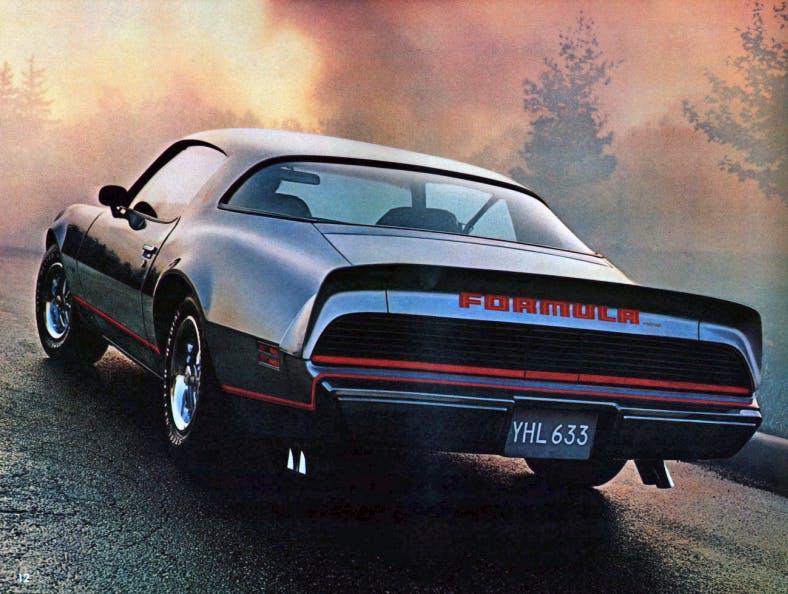
If you’re hunting for one of these cars, you’ve got a lifetime worth of resources for figuring out every possible nut and bolt. Note that most of those resources are going to be focused on the Trans Am and to a lesser extent the Formula, and not necessarily the six-cylinder cars, the Esprits, or the odd trim packages like the Sky Bird. For the most part, though, many of those same resources for everything from headliners to wheel covers will transfer.
FirebirdNation is an excellent forum, with more information in one site than we could possibly add to this document. Check out the sticky topics at the top of the forum, which focus on things like paint colors, fabric types, how to adjust door glass, and where you can find whatever parts you may be looking for.
As with the Camaro, VINs in these cars changed three times during production, so be aware that the information encoded in those VINs will change depending upon the year. There’s a good VIN decoder at Classic Industries.
F-Body Warehouse is a parts supplier specializing in Firebird and Camaro restoration. Their video on what to look for when buying a second-gen Firebird—specifically a Trans Am, but it applies across the trim levels—doesn’t have Ingmar Bergman–level production quality, but the information within is solid and a must-see before you decide to look at one of these cars.
Rust is going to be your biggest concern. It can quickly turn a half-decent prospect into something that’s not much better than a parts car when areas like frames, floors, trunk pans, fenders, rockers, window pinchwelds, and firewalls are rusted beyond reasonable repair. Keep in mind that while these cars do have an excellent aftermarket, the cost for parts and labor to set a car like this right is going to be expensive.
These cars were built in the same two plants as the Camaro, so build sheets will likely be in the same locations—that is, all over the place. They could be tucked under the package shelf, under carpets on the transmission tunnel, over gloveboxes, under the front seat springs, under the rear seat backs, or on top of the fuel tank.
The cowl tags are also a vital source of information. Trans Am Country has good information on cowl tags, from their location to their contents to why it should be considered an international war crime to swap a tag.
Unfortunately, the GM Heritage Center has no information on these cars at all, so you won’t find order guides, brochures, or sales documentation the way you do for a Chevrolet (or a Geo, inexplicably.) All of that information is now with PHS Historical Services, which will sell you a full report on your car based on its VIN for $95 via email in four to five days, or $125 for a rush turnaround.
Before You Buy
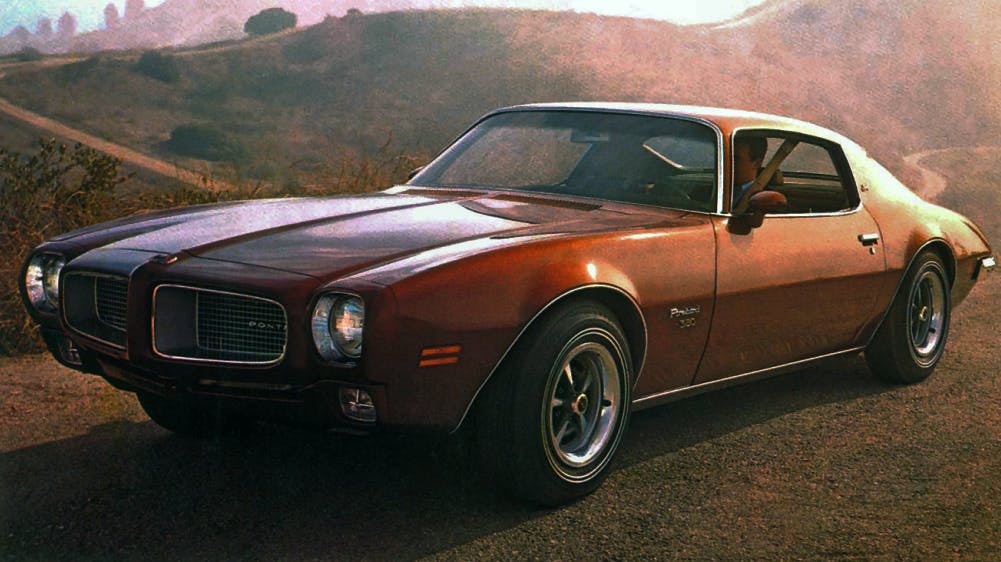
When you’re considering what you’ll have to put into a potential project, know that there really isn’t a part that you can’t source through one of the major suppliers. And some of these aftermarket suppliers are dedicated to nothing but cars from Pontiac, like Ames Performance Engineering. They’re probably the best place to start for technical advice and sourcing. Start with the PDF version of the Firebird catalog. Other suppliers, like Classic Industries, Year One, Classic Muscle, and National Parts Depot, can fill in the gaps. You may need to hunt for highly specific things. For example, the folks at Restore-a-Muscle Car have successfully 3D printed the T-Top headliner trim we mentioned earlier. But the good news is, it’s not like owning a second-generation Buick Riviera, where the only parts available are in a junkyard.
Mechanical components for the Chevy 250, the Buick 3.8-liter, the Pontiac 350, the Pontiac 400, the Olds 400, and the Pontiac 455 are all readily available. F-Body Warehouse even has a number of restoration parts for the 301. Transmissions and rear differentials are plentiful, no matter which example your Firebird came with.
The best car to buy is wildly subjective. Most people are going to be interested in the Trans Ams throughout the build history, but you can have a lifetime’s worth of entertainment with a 1973 Esprit with a 350 and save yourself a boatload of money in the process. Cars like the Sky, Red, or Yellow Birds add an extra element of rarity with period-correct luxury touches, ensuring you’ll never find a duplicate of yours at a local car show.
What to Pay

Since the middle of 2021, median #2 (good) value is up a little more than 20 percent, with even more growth for the Super Duty, though prices stabilized and have been flat for about a year, according to the Hagerty Price Guide, #2 values range from $11,400 for a 1981 Firebird with a 120-hp V-6 to $165,000 for the aforementioned Super Duty. As always, get the latest valuation data from Hagerty by clicking here.
According to Hagerty’s data, it almost doesn’t matter what year of Trans Am you choose, a #1 (concours) example will be expensive. The 1970 and 1973 Trans Ams with the largest engines and four-speed manual transmissions push up over the $200,000 mark, with the best of the rest still fetching around $60K. On the other end of the economic spectrum, there are deals to be had if you don’t necessarily want to go fast. Driver-class 1980 base Firebirds and Esprits with a 350-cid V-8 and an automatic can be had for less than $13,000, and the 301-powered cars are even more affordable.
The count of insurance quotes sought for these cars has remained even in the last year, but the Firebird—in all trim levels—is the sixth-most popular vehicle in Hagerty’s database. Gen X quotes a fairly stunning 40 percent of second-generation Firebirds, even though that cohort makes up a 32 percent share of the market. Right behind them, boomers quote 34 percent of the second-gen cars, about even with their share of the market. Millennials quote 17 percent of second-gen F-bodies, with an even smaller share of the market at 21 percent. Gen Z quotes 8 percent of F-body examples, and comprises exactly the same percentage of the overall market.
Bookended by the memorable blue-and-white early Ram Air cars and the Bandit-era black-and-gold Trans Ams, all of Pontiac’s second-gen Firebirds have come to epitomize the charm of 1970s American iron. Whether you go understated or full bird, this Pontiac delivers plenty of character.
***
Check out the Hagerty Media homepage so you don’t miss a single story, or better yet, bookmark it. To get our best stories delivered right to your inbox, subscribe to our newsletters.


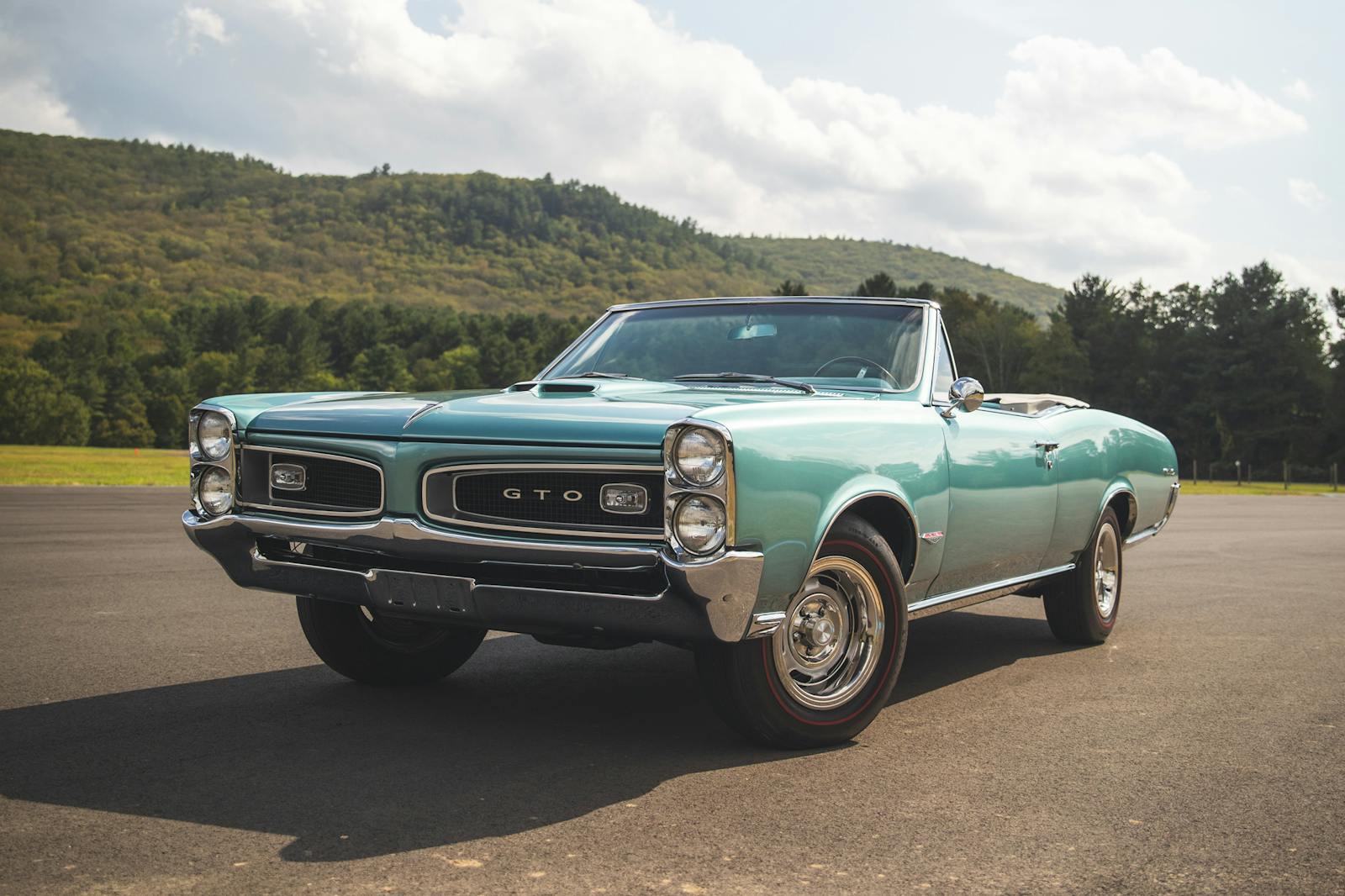
Hi
Minor blonde but the “red bird” Esprits were available in 1978 at least in St Louis .. home of the baseball Cardinals nicknamed the Red Birds
I was 13 and went with my aunt to buy a new practical car …
Somehow I talked her into buying a ‘78 Esprit Red Bird complete w gold scroll “red birds” on the B pillar and I believe on the hood
It was red with red velour interior
Not sure if it was dealer package or Pontiac but sure it was a red bird in the 77-78 body style
Thank You! While I never owned one I was always envious. I was an avid reader of Car & Driver and Motor Trend in my teens (69-76). Closest I came was a ’66 Catalina Convertible when I was 23. The 70-73 Trans Am will always have a place in my heart.
Had mine early, in college, a 1978 black and gold Y82. Bought it for $5k, with 20k miles, in early 1980. Sold it to a coworker about three years later for $3300, who almost immediately totalled it. Still my favorite car, and my current laptop home screen image…..
….a TA, obviously… : )
Ahhh, good memories! Mine was a ’73 Esprit with a pale yellow exterior and black interior. It had the 350 V8 with an automatic tranny. It also had a multi color stripe from the front fender to the rear edge of the door, apparently from the factory. We bought it from a local used car dealer with 50,000 miles on it and I used it to commute to college. Along the way I added the rear spoiler, the steering wheel and the twin downward chrome exhaust pipes from a junked Trans Am. When I sold it after five years with 120,000 miles, it looked better then than when we bought it! Amazingly reliable, with only regular maintenance and a valve job. It’s unfortunate that I didn’t take any pictures of it, as digital cameras didn’t exist in the 70’s.
I remember finding a 76 formula, it was love at first sight,
Gold (exactly like Rockfords car, but it had the bird beak nostrils on the hood).
350 under the hood, so it had just enough power to get me in trouble, I remember doing the Rockford bootleg 180s in every empty parking lot ot street I could get away with it.
I burned up the first set of tires on the car in about 6 months, put on a nice set of low profile 60 Bridgestone RWL, Harder to fry the tires now.
I remember a cop telling me my tires were worn,
I replied, “got a great set of tires waiting at a shop, just want to burn every bit of rubber off these, he chuckled as he got back into his car, (he must’ve been having a good day)
The car developed choke problems, so as I pulled off the cast iton intake, I was halfway there, I put on an aluminum edelbrock with Holly quad, brought my little birdy to life.
She was a gashog 13mpg, so eventually I sold her -waay more money than i paid, her clock was sitting at 90k miles so it was time.
I still miss all the muscle cars I owned.
I look at all the Asian sh!t boxes on the road today and feel sorry for the generations that missed the feel of a big V8, announcing you’re coming and you mean business…